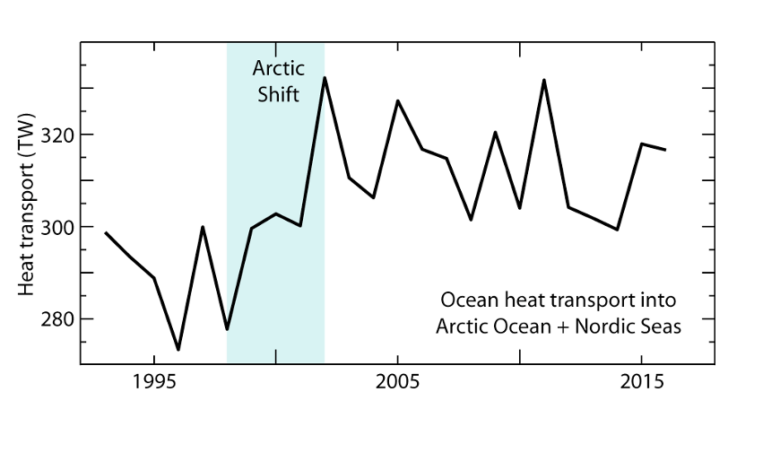Solving the Climate Puzzle: The Sun’s Surprising Role

by Javier Vinos
This post features a chapter from my new book Solving the Climate Puzzle: The Sun’s Surprising Role. The book provides a large body of evidence supporting that changes in the poleward transport of heat are one of the main ways in which the planet’s climate changes naturally. It also shows that changes in solar activity affect this transport, restoring the Sun as a major cause of global warming. Since climate models do not properly represent heat transport and the IPCC reports completely neglect this process, this new hypothesis will not be easily dismissed. I am sure that over time it will lead to a better understanding of how the climate changes naturally, and hopefully less climate hysteria.
Here is the text of Chapter 17 of my new book
- The Ocean’s heat transport is largely wind driven
The ocean is the primary source of poleward heat transport in the tropics, with the tropical Pacific being the dominant player due to its size. It exports heat to the Atlantic and Indian Oceans, which are the only ones to transport heat across the equator. However, inter-basin exchanges are relatively small, indicating that global seawater pathways play a minor role in heat transport. The Atlantic is unique in having an exclusively northward net heat transport due to its meridional overturning circulation, which accounts for about 60% of the heat transported in the North Atlantic. Oceanic heat transport from the North Atlantic to the Nordic Seas and the Arctic increased significantly between 1998 and 2002, during a period of Arctic and global climate shift.
Most of the heat transported by the global ocean is carried by water above 10°C (50 °F), located between 40°N and 40°S at depths of less than 500 m. This transport is primarily due to wind-driven circulation. Even the Atlantic Meridional Overturning Circulation is as sensitive to winds as it is to the formation of high-latitude deep water.
Analysis of the critical tropical upper-layer heat budget has revealed a remarkable 11-year variability associated with the solar cycle that is ten times larger than can be accounted for by changes in solar radiation. In addition, model studies of the Atlantic meridional circulation show that solar forcing is its most important natural determinant. These studies underscore the critical role of the Sun in modulating ocean heat transport by inducing changes in atmospheric circulation.
Ocean heat transport
The ocean plays a critical role in the Earth’s climate system, providing thermal stability and storing a large fraction of the system’s energy. With a total mass 265 times that of the atmosphere and a heat capacity 1000 times greater, the ocean stores 96% of the energy in the climate system and receives 75% of the energy delivered by the Sun to the planet’s surface. This essential feature of the ocean has allowed the existence of complex life. However, because the Earth is currently in an ice age that began 34 million years ago (the Late Cenozoic Ice Age), the ocean has reached a cold state with an average temperature of about 4°C (39 °F), and only the upper mixed layer is substantially warmer due to solar heating and wind-induced turbulence. The sea surface temperature of the open ocean is limited to 30°C (86 °F) because deep convection occurs above 27°C (80 °F), increasing evaporation and forming clouds that effectively cool the surface. Although the upper 2.5 m of the ocean contains as much heat as the entire atmosphere, its main function in climate change is to absorb heat as the planet warms and release it as it cools, providing thermal inertia.
The ocean contributes about 25% of global poleward heat transport (ch. 10). In the tropics, the ocean is the most important heat transporter. Its contribution is even greater in the Northern Hemisphere, where it accounts for about 30% of heat transport. However, the Atlantic Ocean has a unique heat transport pattern. The South Atlantic has a net heat transport towards the equator (fig. 25).
 Figure 25. Ocean heat transport. Mean meridional ocean heat transport (in petawatts) for the global ocean (solid black), Atlantic (dashed red), and Indo-Pacific (dotted blue).[1]
Figure 25. Ocean heat transport. Mean meridional ocean heat transport (in petawatts) for the global ocean (solid black), Atlantic (dashed red), and Indo-Pacific (dotted blue).[1]
Most of the ocean’s heat is transported by water with a temperature above 10°C (50 °F), mainly in the band of the ocean between 40°S and 40°N and above a depth of 500 m. This is the main reason why meridional ocean heat transport is more important at these latitudes, where the Hadley cell is not very effective in transporting heat poleward (ch. 13).
Global ocean heat transport is dominated by heat export from the tropical Pacific, which has the largest tropical surface area and receives the most solar energy. However, it’s striking how much the tropical Pacific dominates heat export to other oceans, exporting four times more heat than is imported into the Atlantic and Arctic oceans. The Atlantic and Indian Oceans transport heat north and south across the equator, respectively, but the Pacific provides this heat through the Drake Passage and the Indonesian Throughflow. While there is some exchange between the basins, it’s relatively small, suggesting that global seawater pathways play a minor role in the Earth’s heat budget.[2]
Poleward heat transport to the Arctic
The Atlantic Ocean has northward heat transport in both hemispheres and across the equator due to the Atlantic Meridional Overturning Circulation. This circulation is part of the thermohaline circulation, which involves the northward flow of warmer, lighter water in the upper layers of the Atlantic and the southward flow of cooler, denser water at depth. Although the two branches are mechanically driven, they are linked by the transformation of warm to cold water masses at high latitudes (ch. 10).
The uniqueness of Atlantic heat transport is highlighted in figure 25 and is related to the asymmetry of the latitudinal temperature gradient between the two hemispheres. Each year, the Southern Hemisphere receives more solar energy than the Northern Hemisphere. This is due to the Earth’s current axial precession, which causes the Southern Hemisphere to be oriented toward the Sun when the Earth is closer to it. Albedo does not correct for this difference due to its interhemispheric symmetry (box 2, ch. 3). Despite receiving a greater annual influx of solar energy, the Southern Hemisphere is about 2°C cooler than the Northern Hemisphere, and the Earth maintains a steeper temperature gradient toward the colder Antarctic than toward the warmer Arctic (ch. 9, fig. 13). Transport theory states that more heat should flow toward the colder pole since temperature differences drive transport. However, the Atlantic transports more heat from the Southern to the Northern Hemisphere, suggesting that energy transport is not solely determined by entropy production. Rather, it is strongly influenced by geographic and climatic factors and thus may be a forcing mechanism for climate change.
The exceptional nature of the Atlantic Ocean’s heat transport has important implications for the climate of the surrounding regions of the North Atlantic, the Arctic, and the global climate. Sea surface temperature in the North Atlantic exhibits a multidecadal oscillation that correlates with global temperature (ch. 19).[3] Analysis of the Atlantic heat flux over time shows a clear relationship between oceanic heat transport and North Atlantic sea surface temperatures (fig. 26). This evidence supports the notion that the oscillation in North Atlantic sea surface temperature is a result of changes in meridional heat transport. Surprisingly, despite this evidence, ocean oscillations are rarely considered in terms of heat transport.

Figure 26. Atlantic heat transport and North Atlantic sea surface temperature. a) Atlantic integrated meridional heat transport over time in petawatts from reanalysis. b) North Atlantic sea surface temperature record for the same period.[4]
The transport of Atlantic water to the Arctic occurs through the Nordic Seas, and the volume and temperature of the transported water strongly influence the climate of northern Europe and the Arctic. The transformation of warm to cold water masses necessary for the Atlantic Meridional Overturning Circulation occurs in the Nordic Seas and the Arctic Ocean. Although oceanic heat transport is a small part of the Arctic heat budget (ch. 11 & 16), its analysis can be very informative. A recent study of ocean heat transport in the Nordic Seas and the Arctic Ocean found a sudden increase in transport. From the 1993-98 average to the 2002-2016 average, oceanic heat transport in this important climate region, the “bellwether” for climate change, increased by 25 terawatts (9%) between 1998 and 2002 (fig. 27).[5]
 Figure 27. The Arctic Shift in ocean transport. Ocean heat transport to the Arctic and Nordic Seas during 1993-2017 shows an abrupt change during the Arctic Shift.
Figure 27. The Arctic Shift in ocean transport. Ocean heat transport to the Arctic and Nordic Seas during 1993-2017 shows an abrupt change during the Arctic Shift.
I refer to the period of rapid climate change in the Arctic that coincided with the change in oceanic transport as the Arctic Shift. As we will see, atmospheric heat transport to the Arctic also increased during the Arctic Shift, not showing the compensation between atmospheric and oceanic heat transport that the models predicted (box 8, ch. 12). It accelerated climate change in the Arctic, a clear demonstration of how changes in transport lead to profound climate changes that are erroneously attributed to anthropogenic forcing. The Arctic Shift was only one of the most conspicuous parts of the most significant global climate shift in 40 years. This issue is discussed in detail in chapter 33.
Wind-driven and thermohaline circulations
Ocean circulation can be divided into two types: fast circulation driven by wind stress, organized into ocean gyres, and slower circulation, related to changes in water density caused by changes in temperature and salinity (thermohaline). These two types of circulation are not independent, as the wind also affects the thermohaline circulation. It is important to note that the term thermohaline circulation, which refers to mass, heat, and salt circulation, can be misleading because heat and salt circulations are different.[6] In the Atlantic, wind-driven and thermohaline circulations contribute to poleward transport, but wind-driven gyres carry most of the heat in other oceans.
Despite its importance for understanding the climate system, our knowledge of the vertical structure of ocean heat transport is poor. This issue is fundamental to the debate over whether abyssal mixing, high-latitude deep-water formation, or winds control oceanic heat transport. This debate has led to unwarranted concerns that the Atlantic overturning circulation could be disrupted, causing significant cooling in Europe. Previous investigations of the vertical structure of oceanic heat transport, taking into account the temperature difference at the ocean-atmosphere boundary, have revealed our misunderstanding of this crucial process.[7] Such analyses show that surface circulation, which is highly sensitive to wind stress, dominates the total oceanic heat transport, while abyssal mixing has virtually no effect. High-latitude deep water formation contributes 60% of the North Atlantic heat transport, but the meridional circulation transport is also proportional to wind stress, being as sensitive to winds as to high-latitude convection.
The results of these studies challenge the common understanding of ocean heat transport as presented in books and illustrated by colorful ribbon diagrams. It is clear that winds play a critical role in ocean heat transport and that the amount of heat transported by the oceans is linearly proportional to the magnitude of wind stress. These findings lead to three controversial and far-reaching conclusions about climate change:
- Atmospheric circulation is primarily responsible for heat transport on a global scale, either directly or through its influence on oceanic transport.
- Atmospheric and oceanic heat transport cannot compensate for each other. Since they are fundamentally linked by wind action, any change in one must be accompanied by a change in the other in the same direction. Consequently, changes in the amount of heat transported poleward are not only possible but inevitable.
- Variability in global heat transport must occur on the decadal timescales typical of atmospheric and upper ocean variability, rather than the centennial or longer timescales characteristic of deep meridional overturning.
Box 14. Response of ocean heat transport to solar variability
Ocean heat transport occurs primarily in shallow tropical waters, so the heat budget of the upper layer is critical to global ocean transport. Studies of the variability of sea surface temperature and pressure have identified typical quasi-biennial and El Niño-Southern Oscillation frequencies, as well as an 11-year frequency. Although this 11-year variability is synchronous with the solar cycle, its magnitude cannot be explained by direct radiative forcing from the Sun at the surface.[8] In the global tropical ocean, the temperature in the upper layer varies by ±0.1°C in phase with the solar cycle, requiring a change of ±0.9 W/m2, while the change in surface radiative forcing from the solar cycle is an order of magnitude too small, ±0.1 W/m2. Therefore, the variability must be due to ocean-atmosphere mechanisms despite its synchronization with the Sun.
The effect of El Niño on ocean heat transport is characterized by the warming of the upper layer of the global tropical ocean, which then warms the overlying atmosphere. In contrast, variability associated with the solar cycle leads to the warming of the global tropical atmosphere, which then heats the underlying ocean. This process is accomplished primarily by reducing the net sensible + latent heat flux from the ocean to the atmosphere, as the increase in solar radiation in the ocean is insufficient. Evidence indicates that the effect of the solar cycle on the ocean is indirect, occurring through the atmosphere. Claims that the Sun cannot be responsible for climate change because of the small change in total solar irradiance that produces its variability ignore the abundant evidence that solar variations act indirectly by affecting atmospheric circulation.
Models agree that solar variability has a significant impact on ocean heat transport. The fully coupled atmosphere-ocean general circulation model of the UK Met Office Hadley Centre shows that solar forcing is the most important natural factor determining the multidecadal response of the Atlantic meridional circulation.[9] Solar forcing is associated with long-lasting anomalies in the atmospheric circulation over the North Atlantic caused by changes in the stratosphere due to weaker solar irradiance during the late 19th and early 20th centuries. The model does not fully capture the atmospheric response to solar variability, but it does show notable changes in the location of the Intertropical Convergence Zone, precipitation in the Amazon, and temperatures in Europe.
In summary
The ocean plays a critical role in transporting heat poleward within the tropics. Wind-driven circulation in the ocean gyres is responsible for most of the heat transport, and a global conveyor has a limited contribution. However, the Atlantic Ocean is an exception, exhibiting net northward heat transport with relevant transequatorial transport, mainly due to the Atlantic Meridional Overturning Circulation, which is sensitive to both wind stress and deep water formation at high latitudes.
The atmosphere, directly through its circulation and indirectly through the effect of wind stress on oceanic transport, is primarily responsible for most of the poleward heat transport. The multidecadal oscillation of sea surface temperature in the North Atlantic results from changes in poleward heat transport. In addition, the upper layer of the tropical ocean shows temperature changes in phase with the solar cycle caused by changes in the atmospheric circulation that affect the heat flux from the ocean to the atmosphere.
Book availability
A 50-page excerpt from the Solving the Climate Puzzle: The Surprising Role of the Sun is available on my ResearchGate page: https://www.researchgate.net/publication/375120132
The English edition of the book is available on Amazon and Google Books, and will soon be available elsewhere through the IngramSpark distribution network. The paperback edition has black and white figures. The Spanish edition should be available later this month, and the German, French, and Italian editions shortly thereafter, with other language editions to follow.
I’d like to thank our gracious host, Judith Curry for her appreciation and support of the book prior to its publication.

[1] Yang, H., et al., 2015. Clim. Dyn. 44, pp.2751–2768. doi.org/10.1007/s00382-014-2380-5
[2] Forget, G. & Ferreira, D., 2019. Nat. Geosci. 12 (5), pp.351–354. doi.org/10.1038/s41561-019-0333-7
[3] Chylek, P., et al., 2014. Geophys. Res. Lett. 41 (5), pp.1689–1697. doi.org/10.1002/2014GL059274
[4] Top plot from Macdonald, A.M. & Baringer, M.O., 2013. Internat. Geophys. Vol. 103, pp. 759–785. doi.org/10.1016/B978-0-12-391851-2.00029-5. Bottom graph, NOAA data.
[5] Tsubouchi, T., et al., 2021. Nat. Clim. Change, 11 (1), pp.21–26. doi.org/10.1038/s41558-020-00941-3. Source of data for fig. 27.
[6] Wunsch, C., 2002. Science, 298 (5596), pp.1179–1181. doi.org/10.1126/science.1079329
[7] Boccaletti, G., et al., 2005. Geophys. Res. Lett. 32 (10) L10603. doi.org/10.1029/2005GL022474 Ferrari, R. & Ferreira, D., 2011. Ocean Model. 38 (3–4), pp.171–186. doi.org/10.1016/j.ocemod.2011.02.013
[8] White, W.B., et al., 2003. J. Geophys. Res. Oceans, 108 (C8) 3248. doi.org/10.1029/2002JC001396
[9] Menary, M.B. & Scaife, A.A., 2014. Clim. Dyn. 42, pp.1347–1362. doi.org/10.1007/s00382-013-2028-x



